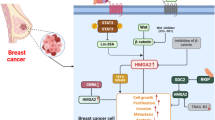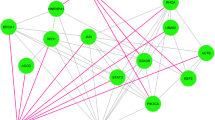Abstract
Noncoding RNAs are key regulators in the Warburg Effect, an emerging hallmark of cancer. We intended to investigate the role and mechanism of circular RNA hsa_circ_0052611 (circ_0052611) and microRNA (miR)-767-5p in breast cancer (BRCA) hallmarks, especially the Warburg Effect. Expression of circ_0052611 and SCAI was downregulated, and miR-767-5p was upregulated in human BRCA tissues and cells; moreover, circ_0052611 acted as a miR-767-5p sponge to modulate the expression of miR-767-5p-targeted SCAI. Functionally, re-expressing circ_0052611 suppressed migration, invasion, glucose uptake, lactate production, and extracellular acidification rate (ECAR) in BRCA cells, and promoted apoptotic rate. These effects were accompanied by decreased Vimentin, N-cadherin, Bcl-2, and LDHA, and increased E-cadherin and Bax. Consistently, exhausting miR-767-5p exerted similar effects in BRCA cells. High miR-767-5p could counteract the role of circ_0052611 overexpression, and low SCAI likewise blocked the role of miR-767-5p deletion. In vivo, upregulating circ_0052611 delayed tumor growth of BRCA cells by altering miR-767-5p and SCAI expression. circ_0052611/miR-767-5p/SCAI axis might boycott the malignancy of BRCA cells.








Similar content being viewed by others
Data Availability
The datasets used and analyzed during the current study are available from the corresponding author on reasonable request.
References
Abdollahzadeh R, Daraei A, Mansoori Y, Sepahvand M, Amoli MM, Tavakkoly-Bazzaz J (2019) Competing endogenous RNA (ceRNA) cross talk and language in ceRNA regulatory networks: a new look at hallmarks of breast cancer. J Cell Physiol 234(7):10080–10100
Bammert L, Jonas S, Ungricht R, Kutay U (2016) Human AATF/Che-1 forms a nucleolar protein complex with NGDN and NOL10 required for 40S ribosomal subunit synthesis. Nucleic Acids Res 44(20):9803–9820
Bandyopadhyay S, Bluth MH, Ali-Fehmi R (2018) Breast carcinoma: updates in Molecular Profiling 2018. Clin Lab Med 38(2):401–420
Brandt DT, Baarlink C, Kitzing TM, Kremmer E, Ivaska J, Nollau P et al (2009) SCAI acts as a suppressor of cancer cell invasion through the transcriptional control of beta1-integrin. Nat Cell Biol 11(5):557–568
Cadoo KA, Traina TA, King TA (2013) Advances in molecular and clinical subtyping of breast cancer and their implications for therapy. Surg Oncol Clin N Am 22(4):823–840
Cairns RA (2015) Drivers of the Warburg phenotype. Cancer J 21(2):56–61
Chen X, Hu W, Xie B, Gao H, Xu C, Chen J (2014) Downregulation of SCAI enhances glioma cell invasion and stem cell like phenotype by activating Wnt/beta-catenin signaling. Biochem Biophys Res Commun 448(2):206–211
Di Leva G, Garofalo M, Croce CM (2014) MicroRNAs in cancer. Annu Rev Pathol 9:287–314
Du Y, Wei N, Ma R, Jiang S, Song D (2020) A mir-210-3p regulon that controls the Warburg effect by modulating HIF-1alpha and p53 activity in triple-negative breast cancer. Cell Death Dis 11(9):731
Feng W, Gentles A, Nair RV, Huang M, Lin Y, Lee CY et al (2014) Targeting unique metabolic properties of breast tumor initiating cells. Stem Cells 32(7):1734–1745
Gasparics A, Kokeny G, Fintha A, Bencs R, Mozes MM, Agoston EI et al (2018) Alterations in SCAI expression during cell plasticity, fibrosis and Cancer. Pathol Oncol Res 24(3):641–651
Geng H, Li K, Pan Q, Tao S, Li C, Zhao H et al (2020) Identification and expression of several circular RNAs and knockdown of hsa_circ_0005556 exerts oncogenic functions by mir-767-5p in gastric Cancer. Med Sci Monit 26:e921163
Hu X, Bao M, Huang J, Zhou L, Zheng S (2020) Identification and validation of novel biomarkers for diagnosis and prognosis of Hepatocellular Carcinoma. Front Oncol 10:541479
Icard P, Shulman S, Farhat D, Steyaert JM, Alifano M, Lincet H (2018) How the Warburg effect supports aggressiveness and drug resistance of cancer cells? Drug Resist Updat 38:1–11
Jia M, Li Z, Pan M, Tao M, Wang J, Lu X (2020) LINC-PINT suppresses the aggressiveness of thyroid Cancer by downregulating mir-767-5p to Induce TET2 expression. Mol Ther Nucleic Acids 22:319–328
Keating E, Martel F (2018) Antimetabolic Effects of polyphenols in breast Cancer cells: focus on glucose uptake and metabolism. Front Nutr 5:25
Li M, He XY, Zhang ZM, Li S, Ren LH, Cao RS et al (2015) MicroRNA-1290 promotes esophageal squamous cell carcinoma cell proliferation and metastasis. World J Gastroenterol 21(11):3245–3255
Li Z, Chen Z, Hu G, Jiang Y (2019) Roles of circular RNA in breast cancer: present and future. Am J Transl Res 11(7):3945–3954
Li X, Xu M, Lv W, Yang X (2020) Ultrasound-targeted microbubble destruction-mediated miR-767 inhibition suppresses tumor progression of non-small cell lung cancer. Exp Ther Med 19(5):3391–3397
Lin L, Liu D, Liang H, Xue L, Su C, Liu M (2015) MiR-1228 promotes breast cancer cell growth and metastasis through targeting SCAI protein. Int J Clin Exp Pathol 8(6):6646–6655
Livak KJ, Schmittgen TD (2001) Analysis of relative gene expression data using real-time quantitative PCR and the 2(-Delta Delta C(T)) method. Methods 25(4):402–408
Lu HF, Yuan WP, Li M, Huang Q, Liu JP, Li LQ et al (2015) Properly assessing CD133 as a risk factor for poor prognosis in patients with hepatocellular carcinoma after resection. Tumour Biol 36(7):4937–4938
Macharia LW, Wanjiru CM, Mureithi MW, Pereira CM, Ferrer VP, Moura-Neto V (2019) MicroRNAs, Hypoxia and the Stem-Like State as Contributors to Cancer aggressiveness. Front Genet 10:125
Mirzaei H, Hamblin MR (2020) Regulation of glycolysis by non-coding RNAs in Cancer: switching on the Warburg Effect. Mol Ther Oncolytics 19:218–239
Misir S, Hepokur C, Aliyazicioglu Y, Enguita FJ (2020) Circular RNAs serve as miRNA sponges in breast cancer. Breast Cancer 27(6):1048–1057
Nan A, Chen L, Zhang N, Jia Y, Li X, Zhou H et al (2019) Circular RNA circNOL10 inhibits Lung Cancer Development by promoting SCLM1-Mediated transcriptional regulation of the humanin polypeptide family. Adv Sci (Weinh) 6(2):1800654
Ou ZL, Luo Z, Wei W, Liang S, Gao TL, Lu YB (2019) Hypoxia-induced shedding of MICA and HIF1A-mediated immune escape of pancreatic cancer cells from NK cells: role of circ_0000977/miR-153 axis. RNA Biol 16(11):1592–1603
Panda AC (2018) Circular RNAs act as miRNA sponges. Adv Exp Med Biol 1087:67–79
Pardini B, Sabo AA, Birolo G, Calin GA (2019) Noncoding RNAs in Extracellular Fluids as Cancer biomarkers: the New Frontier of Liquid Biopsies. Cancers (Basel) 11(8):1170
Percie du Sert N, Hurst V, Ahluwalia A, Alam S, Avey MT, Baker M et al (2020) The ARRIVE guidelines 2.0: updated guidelines for reporting animal research. PLoS Biol 18(7):e3000410
Pinweha P, Rattanapornsompong K, Charoensawan V, Jitrapakdee S (2016) MicroRNAs and oncogenic transcriptional regulatory networks controlling metabolic reprogramming in cancers. Comput Struct Biotechnol J 14:223–233
Plaisier CL, Pan M, Baliga NS (2012) A miRNA-regulatory network explains how dysregulated miRNAs perturb oncogenic processes across diverse cancers. Genome Res 22(11):2302–2314
Rui T, Xu S, Feng S, Zhang X, Huang H, Ling Q (2020) The mir-767-105 cluster: a crucial factor related to the poor prognosis of hepatocellular carcinoma. Biomark Res 8:7
Samec M, Liskova A, Koklesova L, Samuel SM, Zhai K, Buhrmann C et al (2020) Flavonoids against the Warburg phenotype-concepts of predictive, preventive and personalised medicine to cut the Gordian knot of cancer cell metabolism. EPMA J 11(3):377–398
Shankaraiah RC, Veronese A, Sabbioni S, Negrini M (2018) Non-coding RNAs in the reprogramming of glucose metabolism in cancer. Cancer Lett 419:167–174
Singh SK, Singh S, Lillard JW Jr., Singh R (2017) Drug delivery approaches for breast cancer. Int J Nanomedicine 12:6205–6218
Tran AM, Chalbatani GM, Berland L, Cruz De Los Santos M, Raj P, Jalali SA et al (2020) A New World of biomarkers and therapeutics for female Reproductive system and breast cancers: circular RNAs. Front Cell Dev Biol 8:50
Wang Z, Jiang Q, Dong C (2020) Metabolic reprogramming in triple-negative breast cancer. Cancer Biol Med 17(1):44–59
Wang F, Wang X, Li J, Lv P, Han M, Li L et al (2021) CircNOL10 suppresses breast cancer progression by sponging mir-767-5p to regulate SOCS2/JAK/STAT signaling. J Biomed Sci 28(1):4
Wu Z, Wu J, Zhao Q, Fu S, Jin J (2020) Emerging roles of aerobic glycolysis in breast cancer. Clin Transl Oncol 22(5):631–646
Xia M, Feng S, Chen Z, Wen G, Zu X, Zhong J (2020) Non-coding RNAs: key regulators of aerobic glycolysis in breast cancer. Life Sci 250:117579
Xu D, Gu M, Liu HL (2019) MicroRNA-625-3p promotes cell migration of oral squamous cell carcinoma by regulating SCAI expression. Eur Rev Med Pharmacol Sci 23(2):641–648
Yi T, Zhou X, Sang K, Zhou J, Ge L (2019) MicroRNA-1270 modulates papillary thyroid cancer cell development by regulating SCAI. Biomed Pharmacother 109:2357–2364
Yizhak K, Le Devedec SE, Rogkoti VM, Baenke F, de Boer VC, Frezza C et al (2014) A computational study of the Warburg effect identifies metabolic targets inhibiting cancer migration. Mol Syst Biol 10:744
Zhang Y, Tang K, Chen L, Du M, Qu Z (2020a) Exosomal CircGDI2 suppresses oral squamous cell carcinoma progression through the regulation of MiR-424-5p/SCAI Axis. Cancer Manag Res 12:7501–7514
Zhang Y, Zhang Z, Yi Y, Wang Y, Fu J (2020b) CircNOL10 Acts as a sponge of miR-135a/b-5p in suppressing Colorectal Cancer Progression via regulating KLF9. Onco Targets Ther 13:5165–5176
Zhang Y, Qian K, Liu X, Zhao X, Zhao T, Lu G (2022) Exosomal mir-625-3p derived from hypoxic lung cancer cells facilitates metastasis by targeting SCAI. Mol Biol Rep 49(10):9275–9281
Zhou SY, Chen W, Yang SJ, Xu ZH, Hu JH, Zhang HD et al (2019) The emerging role of circular RNAs in breast cancer. Biosci Rep 39(6):BSR20190621
Zubor P, Kubatka P, Dankova Z, Gondova A, Kajo K, Hatok J et al (2018) miRNA in a multiomic context for diagnosis, treatment monitoring and personalized management of metastatic breast cancer. Future Oncol 14(18):1847–1867
Acknowledgements
None.
Funding
This study was supported by
1. The Joint construction project of Medical science and technology in Henan Province, Grant/Award Number: LHGJ20220489.
2. The Joint construction proect of Medica sciece and technology in Henan Province, Grant Award Number: LHGJ20220487.
3. Henan Medical Education Research Project, Grant Award Number:Wjlx2022072.
Author information
Authors and Affiliations
Contributions
Conception and design of experiments: Xin Wang and Zongwen Liu; Experimental part and interpretation of data: Zongwen Liu, Alan Chu and Rui Song; Data analysis and statistics: Rui Song and Shijia Liu; Project administration: Xin Wang; Writing – original draft: Xin Wang, Zongwen Liu; Writing - review and editing: Ting Chai and Chen Sun. All authors read and approved the final manuscript.
Corresponding author
Ethics declarations
Ethics approval and consent to participate
This study was approved by the Ethics Committee of the Second Affiliated Hospital of Zhengzhou University. Animal studies were granted by the Animal Experiment Administration Committee of the Second Affiliated Hospital of Zhengzhou University.
Consent to participate
Not applicable.
Competing interests
The authors declare that they have no conflicts of interest.
Additional information
Publisher’s Note
Springer Nature remains neutral with regard to jurisdictional claims in published maps and institutional affiliations.
Electronic supplementary material
Below is the link to the electronic supplementary material.
Rights and permissions
Springer Nature or its licensor (e.g. a society or other partner) holds exclusive rights to this article under a publishing agreement with the author(s) or other rightsholder(s); author self-archiving of the accepted manuscript version of this article is solely governed by the terms of such publishing agreement and applicable law.
About this article
Cite this article
Wang, X., Liu, Z., Chu, A. et al. Hsa_circ_0052611 and mir-767-5p guide the warburg effect, migration, and invasion of BRCA cells through modulating SCAI. J Bioenerg Biomembr 55, 381–396 (2023). https://doi.org/10.1007/s10863-023-09985-4
Received:
Accepted:
Published:
Issue Date:
DOI: https://doi.org/10.1007/s10863-023-09985-4




